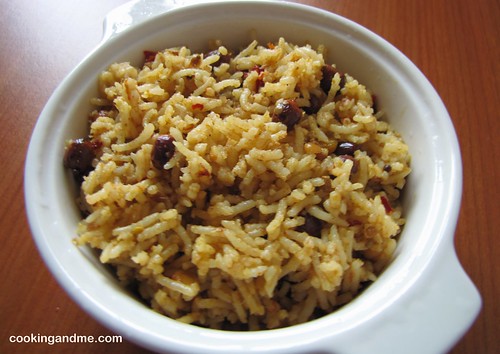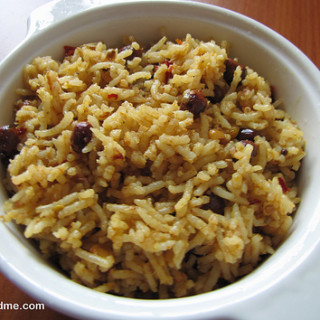Puliyodharai is a very popular South Indian tamarind rice recipe made with tamarind and spices. Puliyodharai is also very commonly served as ‘prasad’ in South Indian temples and the taste of temple tamarind rice is unmatchable.I was gifted Chandra Padmanabhan’s Southern Spice by a colleague in Hyderabad whose exact words when she handed it to me were ‘when I saw the kuzhi paniyaram on the cover, I thought of you’ (Thanks Pragi!!). I am quite glad people think of me when they see delicious food, that’s quite flattering. Anyway, the book has many authentic South Indian recipes.
Chandra Padmanabhan has titled this Tamarind Rice recipe ‘Avasara Puliyodharai‘ – meaning quick tamarind rice in tamil – and since I have an affinity towards any recipe that’s quick, I decided to give it a shot immediately.
Once I read through the list of ingredients and the instructions, I knew this was no quick recipe. There’s a fair bit of roasting and grinding but this recipe does product a delicious Tamarind Rice so I am going to ask you guys to go ahead and give it a shot.

Two things I significantly changed in the recipe are (a) the amount of oil used and (b) the order of soaking, grinding, roasting, etc, so that we use minimum vessels that reduces washing time at the end. I also changed the amount of ingredients here and there but that of course is normal when you follow someone else’s recipe. I have written the actual recipe and changes I made in brackets.
If you love South Indian rice recipes or tangy tamarind recipes, then check out cabbage rice recipe, puli aval (tamarind with poha), curd rice recipe, spicy capsicum rice, and this spinach pulao recipe.

Puliyodharai recipe
Ingredients
- Long-grained rice - 1.5 cups I used basmati rice
- Turmeric powder - 1/4 tsp
- Grated jaggery - 1 tbsp
- Salt - 1/2 tsp or to taste
For the Tamarind Paste
- Tamarind - a large lime-sized ball
- Fenugreek seeds / methi / menthayam / uluva - 3/4 tsp
- Coriander seeds - 1 tbsp
- Dry red chillies - 6 or to taste
- Salt - 1/2 tsp or to taste
For the Pulioyadharai Masala
- Grated coconut - 2 tbsp
- White sesame seeds - 1 tbsp optional
For Tempering
- Sesame seed oil / nallennai / gingelly oil - 3-4 tbsp
- Mustard seeds - 1 tsp
- Asafoetida powder / hing / kaayam - 1/2 tsp
- Dry red chillies - 2 halved
- Urad dal / ulutham paruppu / uzhunnu parippu - 1 tsp
- Chana dal / bengal gram / kadala parippu - 1 tsp
- Curry leaves - a few
For Garnishing
- Sesame seed oil - 2 tbsp optional, add if you find the rice too dry
- Roasted peanuts - 1/4 cup
Instructions
- Wash and soak the rice in 4 cups water for half an hour. Rinse. Cook in an open, thick-bottomed vessel with 4 cups water (add more if it's not enough while cooking) until the rice is cooked yet not too soft.
- Transfer to a colander and let it drip off the excess water. I have found this to be the best way to cook basmati rice since pressure cooking it either makes it under cooked or too mushy.
- Soak tamarind and salt for tamarind paste in 1/2 cup water for 15 mins.
- Soak fenugreek seeds, coriander seeds and red chillies in 1/2 cup water for 15 mins. Drain well. Do all the soaking simultaneously to save time.
- Heat a frying pan and roast the coconut (don't add any oil) till it turns a light brown colour. 6. Remove and roast the sesame seeds (if using) until they start spluttering and turn golden brown. 6. Mix together with the coconut and grind to a fine powder. Keep aside.
- In the same grinder, combine all ingredients for tamarind paste and grind to a fine paste.
- Heat 3-4 tbsp gingelly oil in the same pan and fry the peanuts until crisp. Drain and set aside.
- Add the ingredients for tempering to the same oil. When the mustard seeds start spluttering, add tamarind paste, jaggery, salt, turmeric and 1/2 - 1 cup water.
- Mix well and simmer till all water has evaporated and the mixture has a jam-like consistency. Remove.
- Place rice in a large bowl and gradually blend in the tamarind paste. Sprinkle in spice powder and mix well. Check and adjust salt.
- Add more oil if needed and mix in the roasted peanuts.

Do I have to soak the urad dal and chana dal,used for tempering, in water?
no you don't need to.
its been ages since I had tamarind rice, the best ive had was from our telugu neighbours back in the days. scared to make it though not sure if the lil one and the meat eating hubby will like the taste! sad
Thanks for dropping a note Nisha 🙂 This is a foolproof tamarind rice / puliogare recipe. I have tried it many times too!
i tried this recipe twice now and it came out really very good. thanks for the lovely recipe 🙂
Thanks for dropping a note Nisha 🙂 This is a foolproof tamarind rice / puliogare recipe. I have tried it many times too!
this looks very very delish.